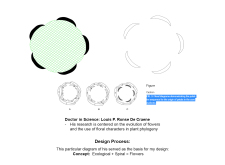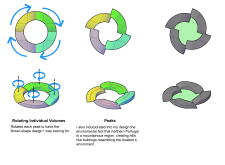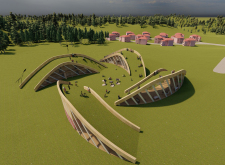5 key facts about this project
The design project is set in the mountainous landscape of northern Portugal, focusing on creating a structure that connects deeply with its natural surroundings. The main idea revolves around the concept of Ecological + Spiral = Flowers, blending elements of nature and organic forms into the built environment. This approach not only informs the aesthetic qualities of the design but also emphasizes the relationship between architecture and the local ecology.
Form and Structure
The design uses a series of volumes rotated to create a shape resembling a flower. This method promotes an engaging interaction with the landscape, allowing the building to resonate with the gentle slopes of the area. The peaks of the structure are designed to mimic the local hills, establishing a visual dialogue that reinforces the bond between the architecture and its surroundings.
Integration with Surroundings
By incorporating features of the local environment directly into the design, the building achieves a strong connection with the geography of northern Portugal. Each peak reflects the delicate forms of flower petals, drawing attention to the unique topography of the region. This relationship fosters a sense of harmony between the natural and the built, creating a welcoming space where users can feel in tune with nature.
Materiality and Sustainability
Though specific materials were not mentioned, the design hints at a focus on sustainable practices. By emphasizing forms inspired by nature, the architectural choices likely promote environmental responsibility. This approach aligns with current trends in building, where considerations for sustainability and ecological sensitivity are increasingly important.
The soft curves of the structure allow light to play across its surfaces, creating shifting patterns that change throughout the day. This quality evokes the gentle movement of flowers swaying in the wind, reinforcing the overall connection to the natural environment.






















































